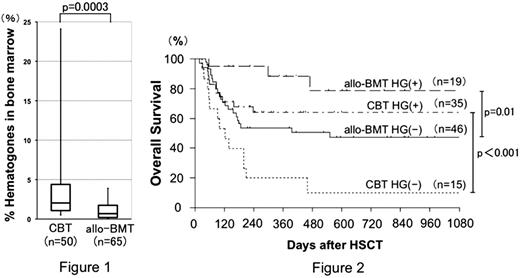Abstract
Abstract 2231
Poster Board II-208
Primary B cell development from hematopoietic stem cells occurs in the bone marrow (BM). During their development, B cell precursors progress through a series of distinct developmental stages; early-B cells, pro-B cells, and pre-B cells. The number of these B cell precursors is gradually declined with aging. Benign B cell precursors, originally termed hematogones (HG), can be observed in the BM during hematopoietic recovery phase in some patients who received chemotherapy or allogeneic bone marrow transplantation (allo-BMT). However, little is known about HG following cord blood stem cell transplantation (CBT). We retrospectively analyzed populations of B cell precursors of BM samples from 115 patients who received allogeneic stem cell transplantation (SCT). Patients included 49 women and 66 men, with a median age of 49 years (19-66 years). The underlying diseases of 115 patients varied; 43 acute myelogenous leukemia, 18 acute lymphocytic leukemia, 4 chronic myelogenous leukemia, 15 myelodysplastic syndrome, 17 malignant lymphoma, and 18 others. 65 patients underwent allo-BMT and 50 underwent CBT. Mean number of the infused cells amounted of 2.80 × 108 cells/kg (0.92-4.02 × 108) for allo-BMT and 2.78 × 107 cells/kg (1.77-5.00 × 107) for CBT. 68 patients received myeloablative conditioning regimen and 47 received reduced intensity conditioning regimen. GVHD prophylaxis included 3 cyclosporine (CSP) alone, 16 CSP and mycophenolate mofetil, 33 CSP and methotrexate (MTX), 5 tacrolimus (Tc) alone, and 58 Tc and MTX. Median time between day 0 of SCT and days performed on evaluation of HG by BM aspiration was 38 days (14-140 days). At that time, engraftment of donor cells was confirmed by chimerism analysis, indicating HG were proven to be donor-origins.
HG were detected averagely in 1.56% of BM cells (0.01-12.27%) for allo-BMT recipients and 7.04% (0.03-55.56%) for CBT recipients, respectively. These results indicated CBT recipients presented much higher frequency and prominent reconstitution of HG compared to allo-BMT recipients (p<0.001, Figure 1). We next analyzed the proportion of HG by comparing donors' age with recipients' age, since B lymphopoiesis is associated with aging under the physiologically condition. Donor's age for CBT was defined as 0 year for analyses. Median age of donor was 37 years (17-66 years). Frequency of HG following SCT significantly declined with increasing the donors' age (p<0.001), but not the recipients' age. Furthermore, episode of acute GVHD presented statistically significant low frequency of HG (p<0.01), whereas chronic GVHD did not. In addition, there was no relationship between the percentage of HG and underlying disease, infectious complications, conditioning regimen. We also analyzed the relationship between HG and overall survival (OS). The existence of HG was defined as the percentage of HG greater than 1% in the BM. Appearance of HG was closely associated with superior OS at 3 years in both allo-BMT and CBT recipients (OS at 3-years, 84% in HG+ BMT pts vs 52% in HG- pts, p<0.05; OS at 3-years, 65% in HG+ CBT pts vs 7% in HG- pts, p<0.001, respectively, Figure 2). In conclusion, predominant reconstitution of HG can be detected following CBT higher than allo-BMT, indicating reconstitution of HG depends on donor's age rather than recipient's age. These findings suggest primary lymphoid development may depend on the intrinsic property of stem cells and progenitors, especially aging, rather than BM microenvironments. Furthermore, appearance of HG might be associated with less occurrence of acute GVHD and superior overall survival. For patients who undergo SCT, HG often can be confused with relapse of their disease. Our study indicated prudent attention should be taken in CBT as well as BMT recipients, and HG might reflect favorable progress in SCT recipients, although clinical significance of expanded HG has not yet been resolved.
No relevant conflicts of interest to declare.
Author notes
Asterisk with author names denotes non-ASH members.


This feature is available to Subscribers Only
Sign In or Create an Account Close Modal